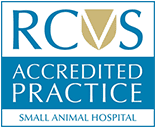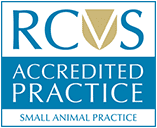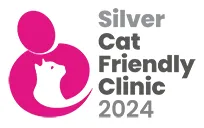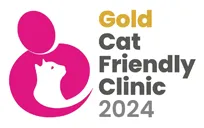Cruciate disease is a common condition that can affect a range of different breeds and different size dogs.
The cruciate ligament is actually made up of two ligaments, the cranial and caudal cruciate ligament.
These ligaments are responsible for keeping the knee joint (stifle) stable. It allows the knee to bend and flex but stops any forward and backward movement.
Cruciate problems can occur in two different ways:
1) As a result of a sudden break in the ligament which usually occurs at exercise – as in footballers. (cruciate rupture)
2) Or as the result of a gradual breakdown in the cruciate ligament resulting in a low-grade grumbling lameness. This may improve when the dog is rested but deteriorate with any increase in exercise. This can subsequently result in cruciate rupture which can cause quite severe almost non weight bearing lameness. (cruciate disease which can lead to cruciate rupture)
Cruciate disease and cruciate rupture both result in pain, inflammation and swelling of the joint cavity and ultimately arthritis of the knee. Sadly a large proportion of dogs will also suffer cruciate disease in their other knee which is likely to ultimately end in cruciate rupture.
Diagnosis
Diagnosis is made by your vet observing your dog’s lameness, examining your pet’s leg – often conscious and under sedation/general anaesthetic, and with x-rays. If your vet is suspicious of cruciate disease they will likely recommend x-rays. This will rule out any other bony abnormality causing lameness such as a fracture or a tumour.
The cruciate ligament itself is not visible on x-ray but subtle signs such as swelling will be visible. The x-ray is performed under sedation or a general anaesthetic which enables us to position your dog’s leg for the x-ray without causing them pain or discomfort. The vet will also assess the knee and check for any excess movement which will indicate cruciate ligament damage.
Your vet is likely to recommend x-raying the other leg for comparison and also the hips.
Treatment
The size, weight and conformation of your dog will help your vet decide which treatment option is best suited for your pet.
This is likely to include surgery to stabilise the joint and there are different techniques available depending on the size, weight and conformation of your dog. Your vet will be able to advise which technique is best for your dog.
Surgery can be performed at our Lowton surgery. We advise to keep patients in the night following surgery to ensure that they are kept comfortable and pain free.
Following surgery your dog will need to be kept strictly rested for 2 weeks before exercise is gradually re-introduced at the direction of the vet. It is really important that you ensure that you follow your vet’s advice carefully to ensure good healing following surgery. Depending on the surgical technique used it may be necessary to x-ray your dog under general anaesthetic 6 weeks after surgery to ensure they are healing well.
Here at My Pets Vets we believe that physiotherapy is an important part of your pets healing and recovery process. We are fortunate to work with a canine physiotherapist on-site physiotherapist who will be able to help your dog recover from their cruciate injury. We are also proud to have our own underwater treadmill (Water Walker) which can be used to help your dog even further.
Prognosis
The prognosis varies between different pets as it is affected by many different things.
Unfortunately we cannot return the knee to how it was pre – injury and an element of arthritis is common. Surgery aims to stabilise the joint and so reduce pain and inflammation, as well as reducing the amount of arthritis that develops and allows your pet to get back exercising sooner than without surgery.
We do recommend joint supplements which can help to improve the cartilage in the joint as well as the joint fluid which lubricates the knee. Please ask your vet regarding which product is most suitable for your pet, it is important to know that human joint supplements are not suitable for dogs as their systems are not the same as ours.
Post-operative Care sheet following orthopaedic surgery
- We advise a bland diet for a few days following surgery, your pet has likely had a long anaesthetic while the surgery was performed. It is common that your pet wants to eat less than normal for a few days post-surgery. If your pet is not eating or only eating very small amounts please contact us.
- It is very common for your pet to be more lame immediately after surgery than before surgery. Many surgeries involve opening the joint itself and cutting bone. If you feel your pet is very sore after surgery please let us know.
- It is extremely important your pet does not lick the wound. It is likely that your pet has had a surgical implant such as a plate or wire placed. If we get an infection around this implant it may require repeated surgeries to remove the implant and the cruciate repair may fail. Contrary to popular belief your pet’s saliva is not clean and pet’s licking wounds is a common cause of infection. We will be able to provide you with a buster collar or other anti-lick device where appropriate.
- Your pet will come home with several different medications. If your pet has had any previous drug reactions please let us know. Please ask us if you have any questions regarding your pet’s medications.
- Your pet needs strict rest for 2 weeks after cruciate surgery, ideally this should be in a crate or small room. Your pet can go outside for toilet breaks on a lead. It is really important your pet is not allowed to walk up or down any stairs or to jump onto or off furniture etc. If you have a particularly excitable dog please ask us about any possible calmers/sedatives that may help to keep them rested and calm after surgery.
- After this 2 weeks of strict rest your dog will be allowed to slowly increase their exercise levels. This return to exercise will depend on which procedure your pet has had. Many dogs will be allowed to have 5 minutes of lead walks approximately 2 weeks after their surgery.
- We will check your dog regularly following surgery and our vets will advise you on their return to exercise, it is really important you follow your vets advice and do not allow your dog to do too much exercise too soon.
- Your vet may advise repeat x-rays at 6-8 weeks post-surgery to ensure the bone is healing as expected. These x-rays will need to be performed under sedation or general anaesthetic. We want to check your pet is healing well before advising increasing exercise too much or allowing them to exercise off lead.
- It is likely that your pet will not be able to exercise off lead until approximately 12 weeks after their surgery. Please follow our vet’s advice regarding this.
- At My Pets Vets we are available 24/7. If you have any concerns regarding your pet please contact us on 01942 417800





